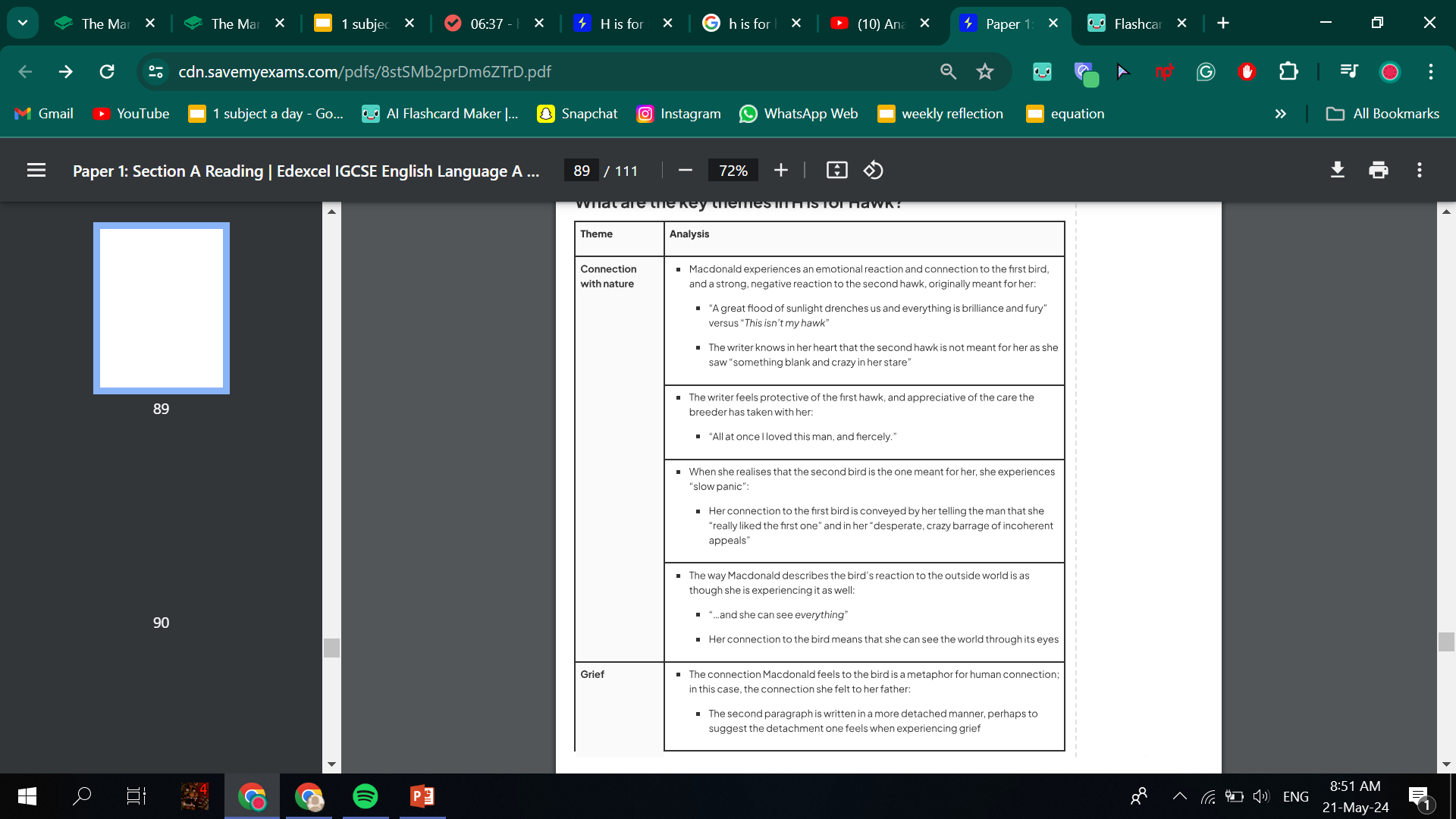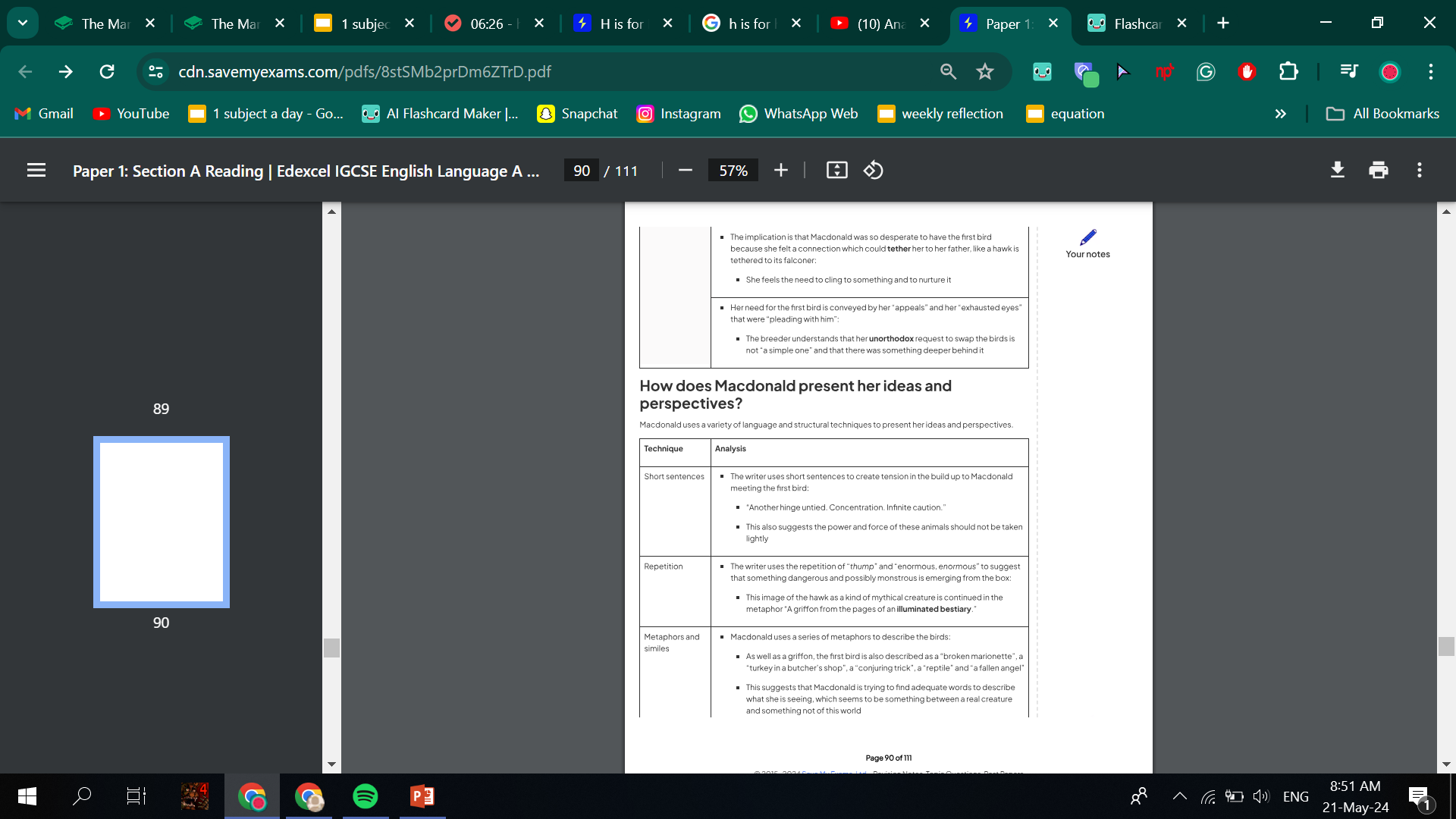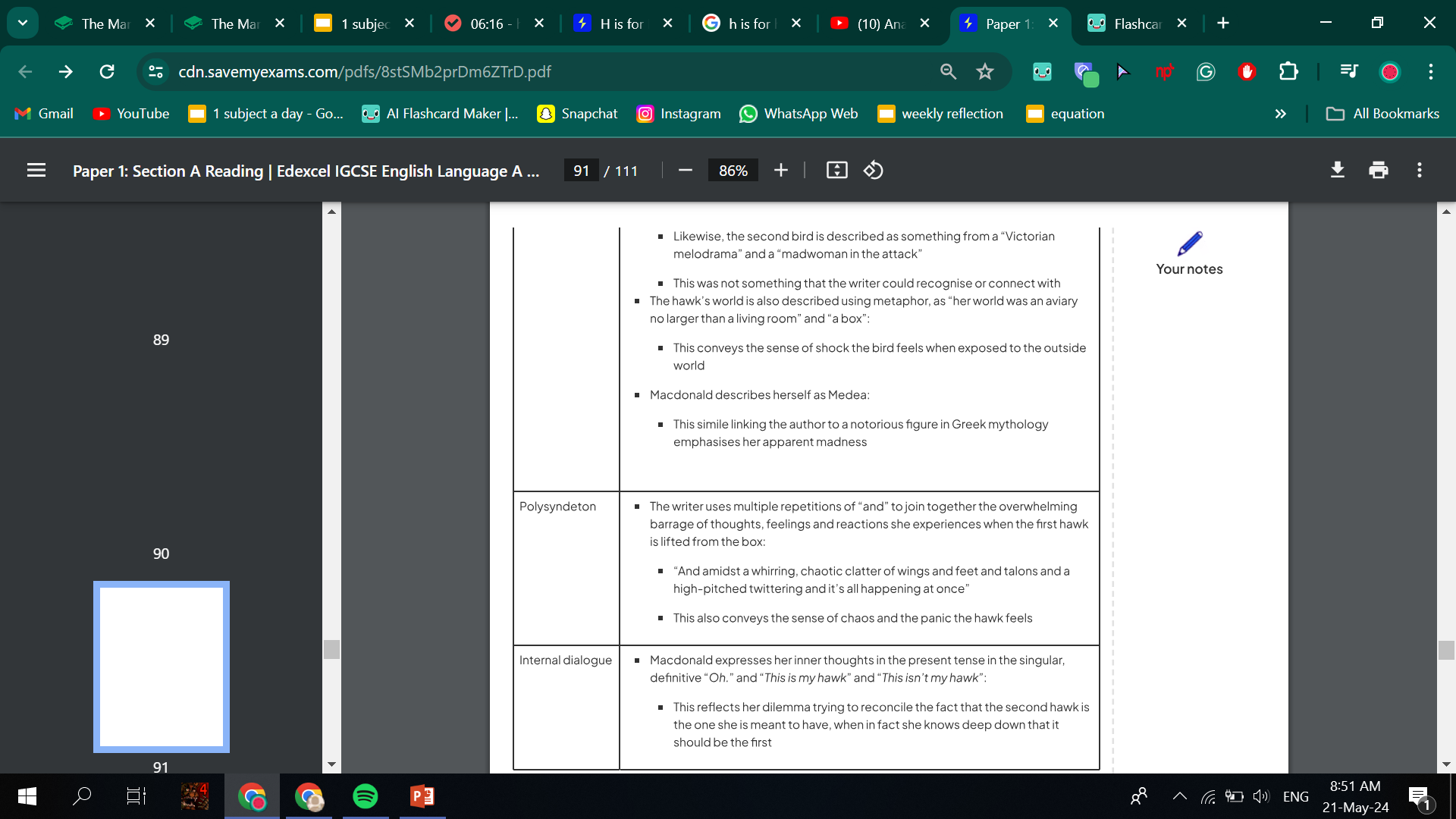h is for hawk
1/6
Earn XP
Description and Tags
Name | Mastery | Learn | Test | Matching | Spaced |
|---|
No study sessions yet.
7 Terms
text type
autobiographical text

themes and emotions
pain
loss
isolation
excited
suspense
freedom
panic
awe

atitudes towards the beginning
The extract begins in media’s res with the goshawk breeder checking his paperwork and carefully unhinging the box containing the bird. There are two birds: Macdonald’s goshawk and someone else’s, so to complete the sale, they must check the numbers on the bird’s ankle tag against the paperwork. Macdonald is excited and creates suspense around meeting the enormous bird for the first time.
keywords: amazement, suspense, tension, amazement, astonishment reverence, enchanted, ethereal, beautiful

atitudes towards the middle
Macdonald sees the bird for the first time as it emerges from the crate and describes its reaction to being let out, as well as her impressions of it. The hawk’s hood has come off, causing her to panic, and Macdonald appreciates the concern of the breeder who had reared her since she hatched in an incubator. She is in awe but is concerned about its she feels its need for freedom.
keywords:calm, control, melodramatic , beautiful imagery, tension
atitudes towards the end
Macdonald helps by putting the hood back on the hawk, butthen they realise thatthis was the wrong bird: she was meantto take home the second one. The other hawk is taken out, but Macdonald does notfeelthe same sense of connection she felt to the first. She asks if it would be possible for her to take the first hawk instead, as she sensed a close bond with it.sense of disapointment as the bird she was in awe of was not the bird she would be taking home. this then causes panic as the new bird feels wild
key words: fear, shock, panic, awkwardness, overwhelming, discomfort, silence
key quotations
“dont want you going home with the wrong bird” situational irony, foreshadowing the plot twist
“her feathers raised like the scattered quills of a fretful porpentine”description build tension and visual imagery, god like in awe and intimidated by it hyperbole+ metaphor= drama
“a fallen angel” and “ a broken marionette of wings, legs and light spashed feathers”
“man was perfectly calm”
“all at once i loved this man and fiercely”
“ her wild eyes were the colour of sun on white paper “
“it was the wrong bird” turning point
“this isn’t my hawk” repetition
“i could take that one instead…?”
“that my stuttered request wasn’t a simple one”
structure of h is for hawk
in the opening sentence the adjective ‘rare’ suggests that these birds are unusual and therefore special • the writer is meeting her bird for the first time and the reader shares the gradual reveal of what is within the box; it is not possible for the writer or the reader to tell what is in the box as the man ‘squinted into its dark interior’
• the onomatopoeic noun ‘thump’ is used to convey a sense of the power of the first bird, emphasised further by the use of italics and repetition of the word
• the fact that the man ‘frowned’ because the hawk has managed to remove its hood suggests that it is perhaps both powerful and scared
• the time immediately before the first bird is seen is described using the metaphor of ‘The last few seconds before a battle’, leading the reader to infer that the bird may be aggressive
• the onomatopoeia used in the phrases ‘whirring, chaotic clatter of wings and feet and talons’ and ‘high-pitched twittering’ conveys a sense of wild noise and confusion, suggesting that the bird may be frightened or panicking
• the repetition of the adjective ‘enormous’ with use of italics emphasises the size of the first bird
• the short sentences containing a range of striking metaphors to describe the writer’s initial impressions of the first bird give contrasting, and possibly confusing, images of what it looks like and show how hard it is for the writer to convey its exact appearance and effect; the simile ‘like gold falling through water’ suggests something very precious
• in contrast to the images of beauty, the writer recounts in apparent horror how ‘For one awful, long moment she is hanging headdownward’ and the simile ‘like a turkey in a butcher’s shop’ suggests that the bird might even be dead
• the writer seems to adopt the perspective of the first bird as she uses asyndeton to convey the incredible precision of the bird’s vision: ‘the pointsource glitter on the waves, a diving cormorant a hundred yards out; pigment flakes under wax on the lines of parked cars; far hills and the heather on them’
• the writer contrasts the power of the bird now with its vulnerability as a ‘lumpen, fluffy chick’ • the description of the bird’s ‘alien brain fizzing and fusing with terror’, with its use of alliteration and half-rhyme, gives a strong impression of how frightening this experience must be for the bird
• the single-line paragraph five with its four short blunt sentences stating at the start that ‘It was the wrong bird’ powerfully conveys the writer’s shock and, as with the first bird, the reader is introduced with the writer to the second bird 7
• the monosyllabic exclamation ‘Oh’, italicised and isolated on the page, momentarily suspends the movement of the narrative, creating a pause before the description of the writer’s horrified reaction to the second hawk
• the writer states bluntly that ‘Everything about this second hawk was different’; the use of comparatives – ‘larger, older… smokier and darker’ – highlights key differences • the dark, Gothic images of the second hawk, seen in the simile ‘like a Victorian melodrama’ and the metaphor ‘A sort of madwoman in the attack’, insinuate something exaggeratedly menacing and sinister about the bird
• the first bird was described as ‘enormous, enormous’ but the second one is ‘much, much bigger’; the repetition of the modifier adds emphasis to the idea of its size
• the writer continues to show the different impressions she has of the two birds by saying of the second bird, ‘instead of twittering, she wailed’ and describing its noise as ‘like a thing in pain’; these serve to enhance the contrast with the first bird and convey the sense that both the bird and the writer are unhappy
• the close positioning in one line of the three words ‘blank’, ‘crazy’, ‘madness’ suggests dangerous and unpredictable qualities in the second hawk • the writer’s statement that ‘I didn’t recognise her’ indicates that she feels no connection with this second bird • the use of italics in the antithetical short statements ‘This is my hawk’, ‘This isn’t my hawk’, ‘But this isn’t my hawk’ and the repetition within the final two sentences draw attention to the writer’s feelings of disbelief and dread, highlighting her reluctance to accept the bird.